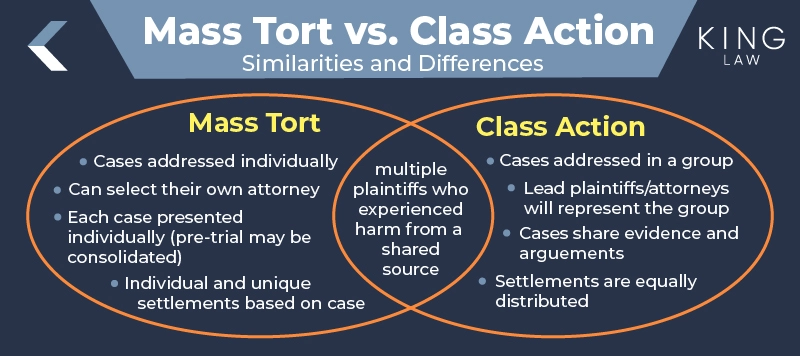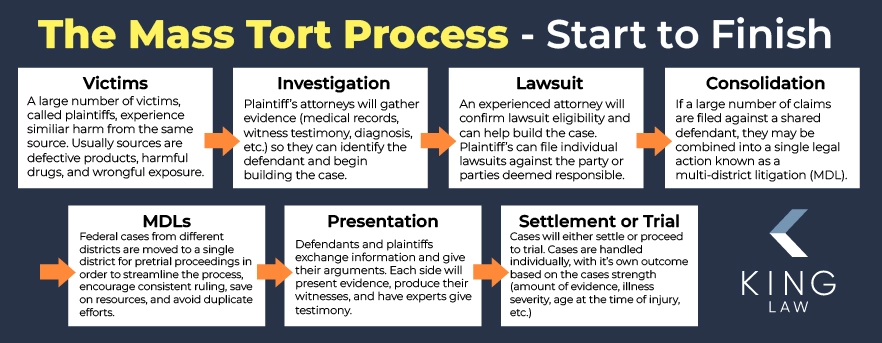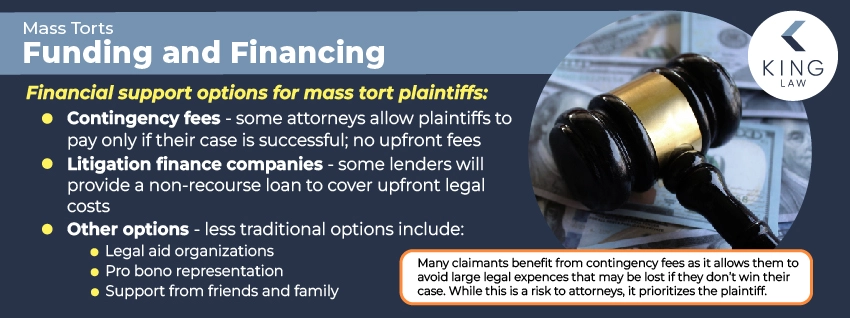Mass Tort Lawsuit Overview
Mass tort lawsuits can occur when numerous plaintiffs experience harm from a shared source. These type of lawsuits are civil lawsuits, which are different from criminal lawsuits that could result in jailtime. In a mass tort, individuals can seek justice and compensation that can help with medical bills, lost wages, and other damages for their injuries. Mass torts also provide an avenue for holding large corporations accountable for negligence and wrongdoings that have harmed a large number of victims.
In a mass tort, plaintiffs’ cases are handled individually, unlike in a class action lawsuit, where plaintiffs’ cases are grouped together. However, in a mass tort, some aspects of the litigation may be consolidated to streamline the process. However, these consolidations usually decrease the burden on plaintiffs. Examples of mass torts include those who have suffered from defective products, environmental exposure, and unsafe pharmaceutical drugs. Learn more about how mass torts work on this page.
What Is a Mass Tort?
Mass torts are legal actions that occur when multiple individuals are harmed by the same action, event, or omission. For example, many people may be harmed by the same drug, medical device, contamination, or consumer product.
In a mass tort, even though each plaintiff has been harmed in a similar way by the same source, each of their cases is handled individually. This means that people who file successful mass tort lawsuits receive compensation that is unique to their injuries and circumstances. Mass tort cases have enough differences that they cannot be part of a class action lawsuit.
For example, many people may be harmed by the same drug made by the same pharmaceutical company. However, each person’s injuries and lifelong outcomes are slightly different. One person affected by this drug may lose their ability to work for the rest of their lives, while another person is out of work for 6 months and then resumes a normal quality of life. Even though these two people are part of the same mass tort lawsuit, their injuries are different and their compensation needs to be different as well. Their circumstances are different enough where a class action lawsuit is not a suitable legal option because the damages caused by the drug are very different. So, people need different levels of compensation, which they would not receive in a class action lawsuit.
Mass Torts vs. Class Actions vs. MDLs
You may hear mass torts, class action lawsuits, and MDLs (multidistrict litigation) being used interchangeably. However, they each have key similarities and differences. Mass torts, MDLs, and class action lawsuits all involve multiple plaintiffs who experienced harm from a shared source. However:
| Mass Tort Lawsuits | Class Action Lawsuits |
|---|---|
|
|
In multidistrict litigation (MDLs), multiple cases from various districts (state courts) are streamlined/consolidated into a single larger claim in federal courts.

Mass Tort Examples
Examples of mass tort lawsuits include:
- Ozempic: Numerous lawsuits have been filed against Novo Nordisk and Eli Lilly after victims developed harmful side effects from drugs like Ozempic and Wegovy. These cases have now been combined in federal mass tort litigation with an appointed leadership structure.
- Asbestos: Asbestos manufacturers continue to face an onslaught of lawsuits from individuals suffering from illnesses like mesothelioma or those who have lost loved ones after wrongful exposure to the carcinogen. Asbestos is one of the most well-known examples of mass tort litigation.
- Groundwater contamination: Water contaminated with harmful chemicals like PFAS has contributed to thousands of lawsuits across the United States from individuals who consumed toxic water and now face serious health conditions like cancer.
Other mass tort cases you may recognize involve defective products like baby formula, hernia mesh, and artificial hips; cancerous products like talcum powder and Roundup®; and medications with serious side effects like Depo-Provera, Suboxone, and Valsartan.
How Do Mass Torts Work? The Process From Start to Finish
Mass torts typically involve the following process:
- A large number of victims, called plaintiffs, experience a similar type of harm from a situation like using a defective product, taking a harmful drug, or experiencing wrongful exposure from environmental contamination.
- During the investigation phase, plaintiffs’ attorneys will gather evidence, identify their defendant, and begin building the case.
- Plaintiffs can file individual lawsuits against the party or parties they deem responsible. An experienced attorney can confirm lawsuit eligibility, help claimants build their case, and file on their behalf.
- If there are a large number of claims with damages and a shared defendant, they can be combined in a higher state court or by the Joint Panel on Multidistrict Litigation into a single legal action known as multidistrict litigation (MDL). Sometimes, similar lawsuits are combined at the state level, in a type of group lawsuit called a multi-county litigation (MCL).
- For MDLs, federal cases from various districts are transferred to a single district for pretrial proceedings. This streamlines the process to avoid duplicative efforts, encourages consistent rulings, and can save resources. For state court consolidations, multiple cases from various state courts are combined into a single proceeding with a single judge.
- Plaintiffs and defendants exchange information, present evidence, and give their arguments. This is when witness depositions and expert testimonies take place.
- Cases then usually either reach a settlement (the plaintiff and defendant can negotiate the award amount) or go to trial for a jury verdict. Each case is handled individually and will reach its own outcome based on the strength of the case (amount of evidence, severity of illness, age at the time of injury, etc.).
Successful mass torts can provide victims with compensation needed to pay for treatments, cover for lost wages, and address other damages that resulted from the defendant’s wrongdoings. In addition, mass torts allow corporations and other responsible parties to be held accountable on a wide scale for their negligence or harm caused that could have been avoided.
Although financial compensation cannot take away pain, suffering, and other impacts of wrongdoings, it can ease monetary burdens on victims and their families. When people hold large companies and corporations accountable for wrongdoing, it can deter these companies from additional negative actions.

How Long Do Mass Tort Lawsuits Take?
Mass torts often take several years from the time of filing to resolution. Some may take just months, while others may take decades. That is why it is important for claimants to contact an attorney as soon as possible to avoid any unnecessary delays in seeking justice and financial support.
Pre-trial motions and hearings are often one of the longest stages of the process and can prolong the timeline. Factors that can influence how long mass torts take include:
- How many plaintiffs there are in the MDL
- Legal and scientific complexity
- Availability and amount of evidence
- The jurisdiction’s legal procedures
- The defendants’ response and desire to settle or pursue a verdict
- Ability to coordinate multiple cases through MDL
Be sure to contact an attorney as soon as possible to begin the legal process and avoid any unnecessary delays. Multiple factors can determine how long civil lawsuits take to settle.
Mass Tort Funding and Financing
There are financial support options that may be available to mass tort plaintiffs:
- Contingency fees: Some attorneys allow plaintiffs to pay only if their case is successful. They pay no upfront fees, and the attorney will collect an agreed-upon percentage of any settlement or reward. Most mass tort lawsuits King Law accepts are on a contingency-fee basis, meaning our clients do not pay anything up front.
- Litigation finance companies: Some lenders will provide a non-recourse loan to cover upfront legal costs. The lender will then collect their funds from the resulting settlement or award. This option can have steep interest rates and fees, reducing how much compensation you walk away with, so it should be pursued with caution.
- Other options: Less traditional options for funding legal expenses may include legal aid organizations, pro bono representation, and support from friends and family.
Talk with an attorney to determine the strength of your case, your opportunity for compensation, and a breakdown of fees and payment timelines. By understanding the total cost of pursuing a lawsuit and when your payments are due, you can make an informed decision that corresponds with your financial situation.
Mass Tort Attorney Fees
Some mass tort attorneys utilize contingency fees. Many claimants benefit from this option and the opportunity to avoid large legal expenses that could be lost if they don’t win their case. While it can be a risk for the attorneys putting in the work, it prioritizes the plaintiff and can ease financial stress that could deter them from filing a lawsuit.
With this arrangement, attorneys and plaintiffs will agree on a contingency, which is a percentage of the final award. This percentage often ranges from 25% to 40%. In addition to the contingency fees, plaintiffs may also need to pay court filing fees, expert witness fees, deposition fees, travel expenses, and more. They may need to pay these costs as they arise or their law firm could cover them and later deduct from the final award amount, which is often more practical for clients. To fully understand your financial obligations, be sure to discuss them with your attorney before starting the legal process.
Through a no-obligation, free consultation with King Law, we can provide you with transparency to make the decision that is right for you.

Average Mass Tort Settlement Amounts
Mass tort settlements can vary greatly and often result in payments of hundreds of thousands of dollars. You may see a settlement anywhere between $100,000 to $1,000,000, depending on the details of your case.
Aspects of a mass tort case that can influence settlement amounts include:
- Extent of damages (medical expenses, treatment costs, lost wages, pain and suffering, etc.)
- Amount and strength of evidence
- Age at the time of injury or diagnosis
- Severity of injury or illness
- Legal strategies of both parties
- Where the case is tried
When you have an initial consultation with an attorney, they can compare your case to others to give you a better understanding of your compensation potential.
Contact a Mass Tort Lawyer
If you’re ready to explore your legal options, contact a mass tort lawyer today. At King Law, we have experience handling these cases and understand what it takes to win. We will provide you with guidance, support, compassion, understanding, expertise, and resources from start to finish. Remember: Choosing the right attorney can have a significant impact on the potential of your case.
To schedule a free, no-obligation consultation:
Fill out our online form.
Call us at (585) 460-2193.
Visit us at 650 Clinton Square, Rochester, NY 14604
Mass Tort Frequently Asked Questions (FAQs)
Learn more about mass torts by reviewing answers to the following frequently asked questions.

